Panama Canal
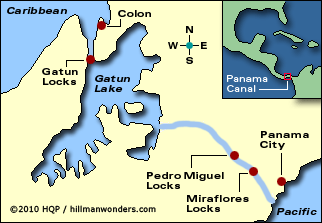 Why a Panama Canal
cruise is special
Why a Panama Canal
cruise is specialThe Panama Canal strategically links the Pacific with the Atlantic Ocean. It has an interesting history. And it gives cruisers an up close view of massive locks in action.
When to go
There are several Panama Canal cruise seasons:
- Mid-December to April
I recommend you sail during this period. It's the driest and best overall Panama Canal season. - May to September
You risk being drenched in downpours. And humidity is uncomfortably high. Most cruise lines avoid sailing during this period - and you should, too. - October to mid-December
Some cruise lines begin their Panama Canal sailing seasons in this period. But heavy rains and high humidity could spoil your vacation. My advice: wait.
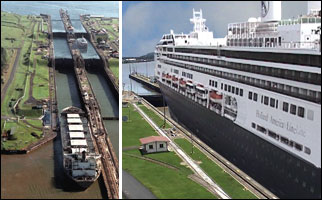 The three types of
Panama Canal cruises
The three types of
Panama Canal cruisesCanal-only cruises are rare. Panama Canal cruises are almost always part of a multiple-destination cruise that include Caribbean (such as Aruba) and/or Pacific coast ports (like Acapulco).
The three basic types of Panama Canal cruises are:
- Full transit
You completely pass through the Panama Canal, from the Atlantic to the Pacific side - or do the reverse. You visit ports on both coasts. This passage could be part of a New York to San Francisco cruise - or even a round-the-world cruise. - Partial transit
Your cruise ship sails to Colon (see map below), then sails through the Gatun Locks to Gatun Lake. After some shore excursion opportunities (which could include a land day trip into the tropical rainforests or even a visit to Pacific side of the Panama Canal), your cruise ship backtracks to the Caribbean.
- No transit
These are essentially Caribbean cruises that dock in Colon as one of their Caribbean ports of call. From Colon, you take a shore excursion to view the Gatun locks.
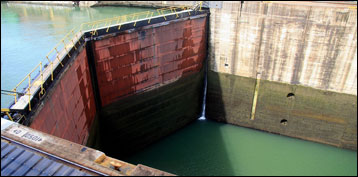 Panama Canal locks
Panama Canal locksWorld's most impressive locks?
They were when I first visited Panama. But now that I've also seen China's relatively new Three Gorges Dam, I know its locks deserve the "most impressive" title. They dwarf the Panama Canal's locks.
Still, the overall Panama Canal system is remarkable and will thrill you.
Panama Canal lock layout
The 24 individual locks are built in parallel pairs to create two lanes for two-way traffic.
Dimensions
Each Panama Canal lock measures 35 meters (110 feet) wide and 305 meters (1000 feet) long.
Water volume
It takes 197,000 kiloliters (52,000 gallons) of water to fill a single lock chamber.
Altitude
The Gatun Locks raise a ship from the Atlantic (Caribbean) side of the Isthmus of Panama to an altitude of 26 meters (85 feet) on Gatun Lake. Then the combined work of the Pedro Miguel Locks and Miraflores Locks lowers the ship back to sea level on the Pacific side of the isthmus. The reverse is true, too.
Tidal effect
The combined lifting and lowering of the three Panama Canal lock systems is about 170 feet, but not always. The exact figure varies because the difference between high and low tide can be as much as 5 meters (17 feet) greater on the Pacific than on he Atlantic (Caribbean) side. Tidal influencers include the moon and sea floor topography.
 Panama Canal sightseeing
Panama Canal sightseeingBest onboard sightseeing vantages
Watching the locks in operation from your ship is a key highlight on a Panama Canal cruise. Side decks (and virtually all cabin balconies) offer poor vantages. The best viewpoints are on the fore deck (the aft deck is second best). And the higher the deck, the better the eagle-eye perspective.
Panama Canal cruise viewing problem
Unfortunately, cruise ships generally don't have sufficient fore and aft deck space to accommodate all their view-seeking passengers. Standing three deep at the railing is not uncommon. This is especially bad for photographers and short people. It's wise to arrive early to stake out your unobstructed railing spot.
Shore excursion
The best are rainforest excursions you take when the ship arrives in fresh-water Gatun Lake.
Night crossings
Be aware that some cruise ships are scheduled to pass through the Panama Canal at night. That's not what most cruisers come to do. Make sure the cruise you book has a scheduled daylight transit. Even then, you could be stuck with a night passage. Reasons include an unavoidable delayed cruise schedule or an unanticipated major traffic backup on the waterway.
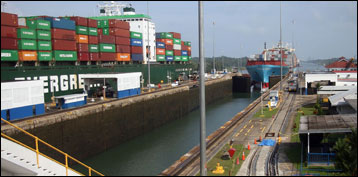 More
Panama Canal
tips and insights
More
Panama Canal
tips and insightsCruise length
The average length of a Panama Canal cruise is 14 nights for full-transit voyages. Partial-and non-transits average about 10 nights.
Hours of operation
The Panama Canal is open 24 hours a day, 365 days a year.
Mules
These railed locomotives pull and guide ships through the locks. They were nicknamed "mules" when they replaced the animal long ago.
Cargo
Most of the cargo that passes through the Panama Canal is coming from or going to the USA. The majority of the ships are Asian (primarily Chinese and Japanese).
Ownership
The Panama Canal is owned by the Panamanian government (since the end of the last century).
Panama Canal is complex
It's a vast, intricate system of mighty locks, artificial lakes, man-made channels, herculean machinery, and sophisticated navigation and communication electronics. If something major would go amiss, the effect on maritime trade would be acutely felt around the world.
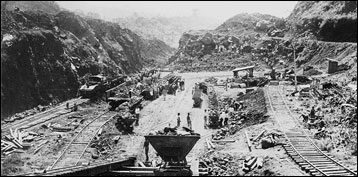 History in brief
History in briefMost significant periods
- 1630s
King Charles I of Spain orders a survey to determine whether a canal is feasible. He listens to his experts and wisely drops the idea. - 1880s
The French, who just successfully built the amazing Suez Canal, make an all-out effort to develop the Panama Canal. But desert and tropical rainforest conditions are decidedly different. More than 20,000 workers die (mainly due to tropical diseases like malaria and yellow fever). The project went bankrupt and folds. - 1904 to 1914
Americans take over, this time successfully, but - as with the French - at a terrible human cost. Over 5,000 workers die of tropical diseases and work accidents such as landslides.
The Panamanian government is building a third lane of locks to handle today's cargo and cruise megaships.
Geography
Location
The Panama Canal was strategically built in the narrowest, lowest lying part of Central America.
Shorcut
The Panama Canal saves mariners significant time, distance, and fuel - and reduces sea risks. Without it, ships would have to sail around the southern tip of South America. That would add several weeks and 12,500 kilometers (7800 miles). And the sea at the southern end of the continent can be dangerously rough.
Trick question
"Which is farther west, the Panama Canal's Pacific entrance or its Atlantic (Caribbean) entrance?"
"Pacific" sounds like the logical answer, but it's wrong. "Atlantic" is the correct answer. The Atlantic side is 40 kilometers (25 miles) west of the Pacific side. Reasons: The isthmus at the canal's location bends northeast (not south). And, the Panama Canal is built on a southeast-to-northwest orientation.


